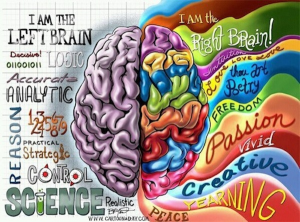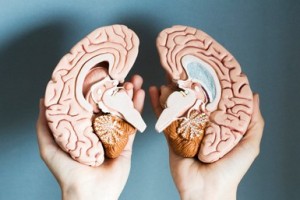“To be yourself in a world that is constantly trying to make you something else is the greatest accomplishment.” -Ralph Waldo Emerson

So which one are you? Right-brained or left-brained? You might have looked at the image and think “Uh huh, yup, that’s so me.” Or “Hmm, that doesn’t really suit me.” It’s likely that you’ve found some things on both sides to be true to how you understand yourself. Depending on the situation, you may even alternate between certain traits. Categorizing people into either/or boxes creates a false schism that misses the complexity of the brain’s interconnectedness.
Some people tend to use one side more than the other, but we use most of our brain in the everyday tasks that we do. In the professional world, some employers try to quantify people by what part of the brain they use the most due to the hemispheric differences that have been identified in the brain. There are even tests that classify people into ‘expected’ careers based on their hemispheric dominance. For example, left-brain thinkers are thought to be more suitable to be engineers, computer technicians, and financial advisors as the left hemisphere is associated with logic and objectivity. In contrast, right-brain thinkers are considered more intuitive and creative.
Teachers in the education field have also been trying to identify and group children based on what side of the brain they use the most. However, they then target them with techniques to challenge the other side. For example, right-brained activities such as show and tell are used to stimulate the right brain of left brain dominant students. These methods support a more holistic use of the brain instead of focusing on activities that target a certain hemisphere. The table below presents supposed personality traits and teaching styles associated with each hemisphere.
| Left Hemisphere | Right Hemisphere |
|
|
| Teaching style |
- verbal instructions
- talking and writing
- multiple choice tests
Teaching style
- demonstrated instructions
- drawing and manipulating objects
- Prefers open ended question
However, our brain is not a single machine that has distinct parts; it is a machinery that is interconnected in so many ways. Targeting certain children with certain activities may limit the potential of these children to learn new ways of learning or challenging themselves. By concentrating on just one side of the brain, children may not learn to use their brain as a whole at a young age, which can affect them unto adulthood.

One way to consider the true implications of hemispheric dominance is to consider hand dominance. When it comes to motor control, people might be right-handed, left-handed, or ambidextrous. Right-handed individuals may be able to write, catch, or shoot a ball better with their right hand than with their left hand, but that does not mean that they do not use their left hand at all. Interestingly, Knecht et al. (2000) found a relationship between atypical hemispheric language dominance and left handedness. In other words, individuals who processed language predominantly in their right hemisphere were more likely to be left-handed. However, there were also left handed and right handed individuals, who processed language in the same hemisphere which controlled their handedness . This further supports the notion that there is no uniform categorization for laterality. As such, we should not extrapolate evidence of hemispheric dominance to characterize an individual’s personality or identity.
Though there is a common claim that the left brain is responsible for the language, it is not that simple. This idea came from the experimental result that the damage to the left hemisphere is always related to difficulties dealing with languages. What’s more, a similar damage dealt to the right hemisphere is much less likely to cause such language associated problem.

Dr. Dedermeier, a professor of psychology at UIUC, claimed that her laboratory figured out that both hemispheres contribute to the understanding of words and sentences. Therefore, she says that the ability to understand language does require both hemispheres working together as well as separately. According to Dedermeier, when both hemispheres are connected, they do not just share all information and operate in a unified system. The corpus callosum, which connects our left hemisphere and right hemisphere, is not big nor strong enough to support them for full information sharing. Comparably, the corpus callosum is smaller to the rich and dense network of connection of hemisphere. Thus, dealing with things separately is more efficient and smarter for our brains to do so.
Furthermore, evidence suggests that functional differences between the two hemispheres are limited at best. For example, Nielson et. al (2013) performed brain scans of over 1011 people from ages 7 to 29 over a two year time span. They used functional magnetic resonance imaging (fMRI) to measure the functional lateralization, specific mental processes, that occur in the two hemispheres. They found that the individual differences do not favor one side over the other. However, Nielson does admit that some brain functions occur in one side of the brain. Overall, no one is exclusively right-brained nor left-brained.
Although pseudoscience such as this may be fun and interesting at times, it is not suitable as a classification system that places people nice and neatly into different categories. This type of miscategorization may contribute to an unfair bias towards others such as prospective employees. Each individual’s brain is unique in its function, and things such as careers are impacted not only by the brain but also by environmental factors. People have certain behavioral and cognitive tendencies based on their biological makeup. However, environmental factors contribute as to which characteristics become expressed during one’s life. Right brain vs left brain and other personality tests like this ought to be interpreted as descriptive rather than prescriptive.
Resources:
Bhatta, N. “Left Brain-Right Brain Diversity.” Left Brain-Right Brain Diversity. Who Are the Sikhs, n.d. Web. 01 Sept. 2015.
Knecht, S., Dräger, B., Deppe, M., Bobe, L., Lohmann, H., Flöel, A., … & Henningsen, H. (2000). Handedness and hemispheric language dominance in healthy humans. Brain, 123(12), 2512-2518.
Lambrozo, T. (2013, December 2). The Truth About The Left Brain / Right Brain Relationship. Retrieved September 4, 2015, from http://www.npr.org/sections/13.7/2013/12/02/248089436/the-truth-about-the-left-brain-right-brain-relationship
Neuromyth 6 – OECD. (n.d.). Retrieved September 4, 2015, from http://www.oecd.org/edu/ceri/neuromyth6.htm
Nielsen, Jared A., Brandon A. Zielinski, Michael A. Ferguson, Janet E. Lainhart, and Jeffrey S. Anderson. “An Evaluation of the Left-Brain vs. Right-Brain Hypothesis with Resting State Functional Connectivity Magnetic Resonance Imaging.”PLoS ONE 8.8 (2013): n. pag. Web
